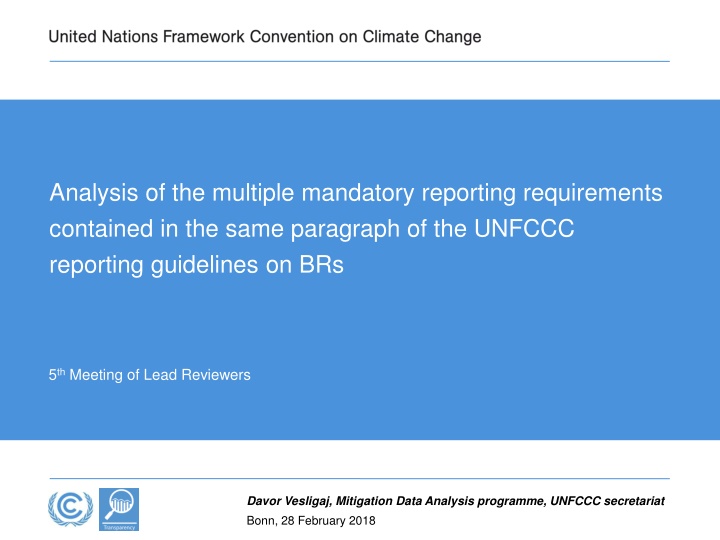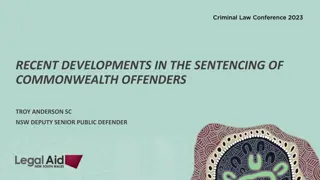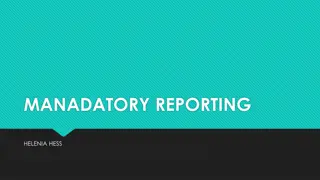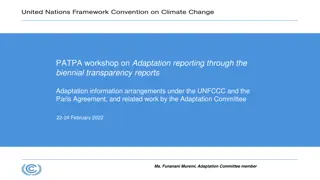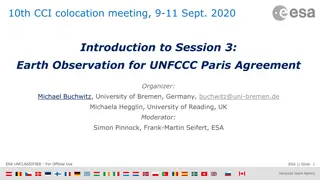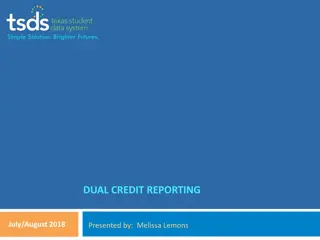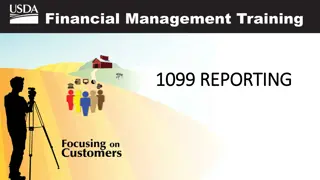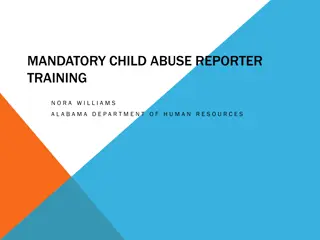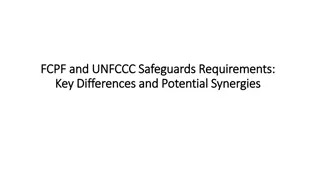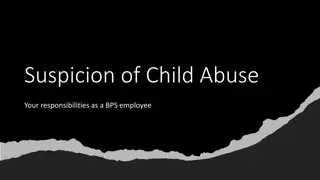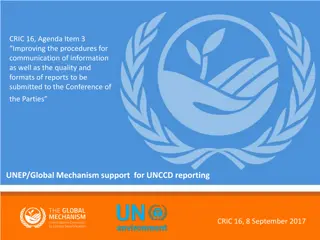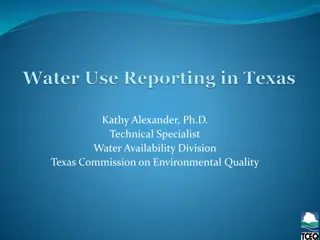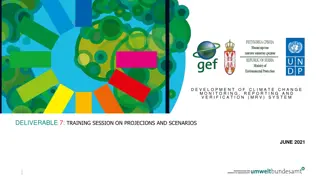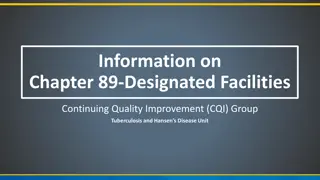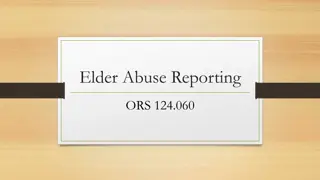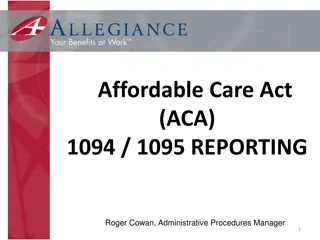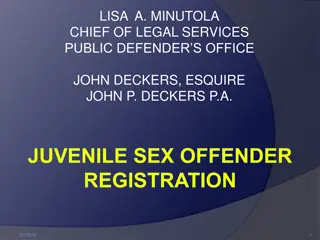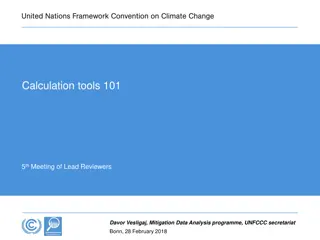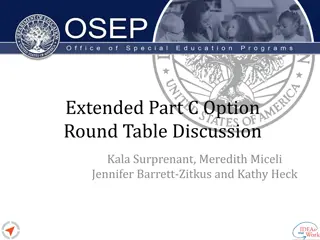Analysis of Mandatory Reporting Requirements in UNFCCC Guidelines
The analysis explores the treatment of multiple mandatory reporting requirements in the same paragraph of the UNFCCC reporting guidelines, focusing on deconstruction, recommendations, and guiding principles derived from technical reviews.
Download Presentation

Please find below an Image/Link to download the presentation.
The content on the website is provided AS IS for your information and personal use only. It may not be sold, licensed, or shared on other websites without obtaining consent from the author.If you encounter any issues during the download, it is possible that the publisher has removed the file from their server.
You are allowed to download the files provided on this website for personal or commercial use, subject to the condition that they are used lawfully. All files are the property of their respective owners.
The content on the website is provided AS IS for your information and personal use only. It may not be sold, licensed, or shared on other websites without obtaining consent from the author.
E N D
Presentation Transcript
Analysis of the multiple mandatory reporting requirements contained in the same paragraph of the UNFCCC reporting guidelines on BRs 5th Meeting of Lead Reviewers Davor Vesligaj, Mitigation Data Analysis programme, UNFCCC secretariat Bonn, 28 February 2018
Outline of the presentation Introduction Approach to the analysis Relationships between shall-s ERTs approach in considering multiple shall-s Results of analysis per each paragraph Conclusions for consideration by the LRs
Introduction Request from the LRs Explore how the multiple mandatory reporting requirements contained in the same paragraph of the UNFCCC reporting guidelines on BRs were considered in the technical reviews of BR1s and BR2s following the guiding principle that one missing mandatory requirement should trigger no more than one recommendation . Scope of work 5 relevant paragraphs were analyzed i.e. 6, 14, 15, 17 and 22. Background paper with an in-depth analysis of the experience from the technical reviews of the BR1s and BR2s was prepared as an input to LRs discussion (available at http://unfccc.int/national_reports/biennial_reports_and_iar/items/10507.php)
Systematic approach to the analysis 1. Paragraphs 6, 14, 15, 17 and 22 were deconstructed to the reporting parameters contained in each shall requirement understanding of their relationship and interdependencies; 2. All ERTs recommendations relevant to these five paragraphs were extracted from TRR.1s and TRR.2s and sorted out according to shall requirements understanding of how ERTs considered multiple mandatory reporting requirements during reviews; 3. Based on steps 1. and 2., some guiding principles were deduced related to the assessment of completeness and transparency and the associated number of recommendations made by ERTs in addressing them.
Two types of multiple shall-s: interdependent and overlapping 1. Interdependent : when the first shall requirement refers to the main content of the reporting while subsequent (the second and third) shall relate to reporting specific parameters related to the first shall : para. 6 (2 shall ): mitigation actions and sectors and gases affected by the mitigation actions; para. 14 (2 shall ): a national approach for tracking support and indicators, delivery mechanisms and allocation channels used to track the support; para. 17 (2 shall ): financial support provided, committed and/or pledged and allocation channels and annual contributions (paragraph 17); para. 22 (3 shall ): measures and activities related to technology transfer and recipient country, target area, sector involved and sources (public or private). Overlapping : when there are more than one requirements that request certain actions on the 2. same subject matter, using different terms with largely the same meaning: para. 15 (3 shall ): use, describe and report methodology for the reporting of financial information.
ERTs applied different approaches in considering multiple shall-s If a Party provides complete and transparent information on one of the shall but fails to provide complete and transparent information on other shall , ERTs make one recommendation to report the missing or not transparent information; This is in line with the guiding principle from RPG. If a Party fails to provide complete and transparent information on more than one of the shall , ERTs either: Make one integral recommendation covering all reporting requirements; Make more than one recommendation, each covering a different reporting requirement.
Results of the analysis para 6 Each Annex I Party shallprovide information on its mitigation actions . To the extent appropriate, Parties shallorganize the reporting of mitigation actions by sector and by gas. ERT s recommendations 1st shall 2nd shall 1st and 2nd shall TRR.1 TRR.2 TRR.1 TRR.2 TRR.1 TRR.2 6 9 7 5 3 2 1st and 2nd shall : 1 integral recommendation in 4 cases: The ERT recommends that the Party provide information on individual mitigation actions, organized by sector and by gas, to the extent appropriate, in its next BR submission. 2 recommendations in 1 case: The ERT recommends that Party report complete and comprehensive information on mitigation actions in its CTF table 3 The ERT also recommends that Party include this information in its next BR organized by sector and gas.
Results of the analysis paragraph 14 Each Annex II Party shall provide a description of its national approach for tracking of the provision of FTC support to non-Annex I Parties, if appropriate. This description shall also include information on indicators and delivery mechanisms used and allocation channels tracked. ERT s recommendations 1st shall 2nd shall 1st and 2nd shall TRR.1 TRR.2 TRR.1 TRR.2 TRR.1 TRR.2 5 6 2 3 8 3 1st and 2nd shall : 1 integral recommendation in 8 cases: The ERT recommends that the Party provide description of its national approach for tracking the provision of financial support to non-Annex I Parties, including information on indicators and delivery mechanisms used and allocation channels tracked. 2 recommendations in 3 cases: The ERT recommends that Party provide a description of its national approach for tracking of the provision of financial, technological and capacity-building support to non-Annex I Parties The ERT also recommends that this description include information on indicators and delivery mechanisms used and allocation channels tracked.
Results of the analysis paragraph 15 Parties shall use any methodologyto be developed under the Convention, . Annex II Parties shall describe the methodology used in their biennial reports. Annex II Parties shall report in a rigorous, robust and transparent manner the underlying assumptions and methodologies used to produce information on finance. ERT s recommendations 1st shall 2nd shall 3rd shall 1st, 2nd and 3rd shall TRR.1 TRR.2 TRR.1 TRR.2 TRR.1 TRR.2 TRR.1 TRR.2 0 0 0 0 10 4 0 0 12 cases of merging requirements from different paragraphs in one recommendation: e.g. The ERT recommends that the Party include more information in its reports regarding the national approach (para. 14) for tracking the provision of financial support and the methodologies (para. 15) used in reporting information on financial support, and how resources (effectively) address (para. 16) the needs of non-Annex I Parties. Not considered as a good review practice. Should be avoided.
Results of the analysis paragraph 17 Each Annex II Party shall provide information on the financial support it has provided, committed and/or pledged for the purpose of where appropriate. To that end, each Annex II Party shall provide summary information in a textual and tabular format on allocation channels and annual contributions for the previous two calendar or financial years ERT s recommendations 1st shall 2nd shall 1st and 2nd shall TRR.1 TRR.2 TRR.1 TRR.2 TRR.1 TRR.2 1 1 0 1 0 0 1st and 2nd shall : no relevant cases
Results of the analysis paragraph 22 Each Annex II Party shall provide, in textual and tabular formats, information on measures and activities related to technology transfer . In reporting such measures and activities, Annex II Parties shall, to the extent possible, provide information on , and shall distinguish between activities undertaken by the public and private sectors ERT s recommendations 1st shall 2nd shall 3rd shall 1st, 2nd and 3rd shall TRR.1 TRR.2 TRR.1 TRR.2 TRR.1 TRR.2 TRR.1 TRR.2 1 0 0 0 1 0 0 0 1st, 2nd and 3rd shall : no relevant cases
Main conclusions of the analysis The analysis shows that in all cases where Parties provided complete and transparent information on one of the mandatory reporting requirements but did not provide complete and transparent information on the other reporting requirement contained in the same paragraph, ERTs made one recommendation; This is in line with the RPG. In cases where Parties did not provide complete and transparent information on more than one of the interdepended mandatory reporting requirements, specifically in paragraphs 6 and 14, only in a few cases the ERTs followed the RPG and made a recommendation for each individual reporting requirement; However, in most cases the ERTs made one integral recommendation that covered all interdependent reporting requirements. There were 13 cases in TRR.1 and TRR.2s where ERTs made one recommendation that merged two or more mandatory reporting requirements contained in different paragraphs of the UNFCCC reporting guidelines on BRs (i.e.13, 14, 15, 16, 21 and 22). This approach is not considered as a good review practice and therefore should be avoided.
Conclusions and recommendations for consideration by LRs 1. The LRs welcomed the background paper Multiple mandatory reporting requirements contained in the same paragraph of the UNFCCC biennial reporting guidelines for developed country parties: Analysis of the experience from the technical reviews of the first and second biennial reports prepared by the secretariat. 2. The LRs recommends that in cases where Parties did not provide complete and transparent information on more than one of the mandatory reporting requirements contained in the same paragraph of the UNFCCC reporting guidelines on BRs (i.e. 6, 14, 15, 17 and 22), the ERTs should made one integral recommendation that covers all reporting requirements. 3. Regarding overall assessment of completeness and transparency of an individual section of the BR, ERTs should continue to use the completeness and transparency assessment scoreboard from RPG. However, ERTs should apply expert judgment to make a final decision on the level of completeness and transparency of relevant sections of the BR, considering the scope of missing, incomplete or not transparent reporting parameters pertaining to paragraphs 6, 14, 15, 17 and 22 in each particular case. This approach should be reflected in the RPG.
Conclusions and recommendations for consideration by LRs 4. ERTs should avoid making recommendations that contain two or more mandatory reporting requirements from different paragraphs of the UNFCCC reporting guidelines on BRs. 5. To further facilitate the consistency and effectiveness of the review, it would be helpful to analyse the approaches and expert judgements applied in the TRR.3s and assess how review practice in the assessment of completeness and transparency has evolved overtime.
Q/A Thank you!
